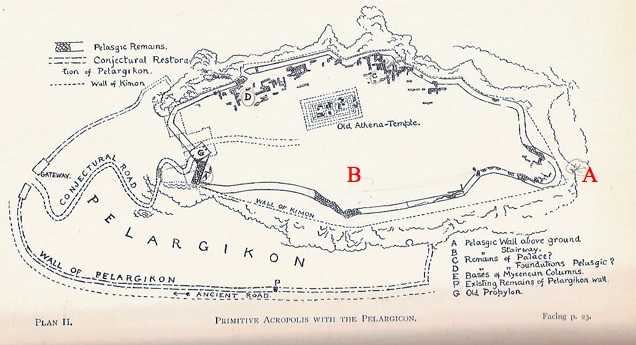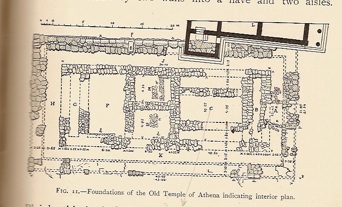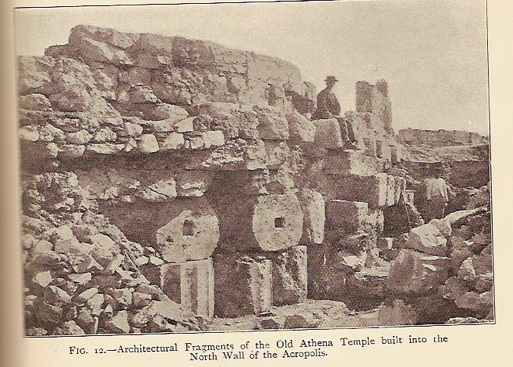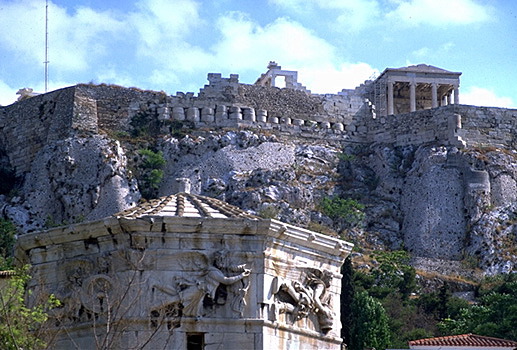PREHISTORIC ACROPOLIS
Since the prehistoric times, Acropolis was closely related with myths and shrines of Athenians, or Mycenaeans some population of whom were supposedly resided in this area. Unlike Preclean Acropolis, it served as a citadel, residence of the ruling class, sanctuary, and treasury.
Acropolis gained its historic distinction when the Cecropids established themselves upon its summit as their fortress and had Zeus their patron Divinity. There also had been numerous gods and goddesses worshiped by the residents, but Athena gradually became the main figure.
During this time, the Acropolis grew more to be a place of sanctuaries, but also it was a residence for the ruling class and formed the center and the capitol of the settlement growing up around its base.
On the north part of the Acropolis, there remain some ancient walls and foundations of prehistoric date belonging to the ancient palace of the Athenian kings, one of whom being Erechtheus referred to in the Odyssey. Also the Old temple of Athena which proceeds the older Parthenon and Periclean Parthenon is credited to this period.
EARLIEST HISTORIC PERIOD
Acropolis first comes into the light of history (or semi-history) around 630 BCE, when Kylon (or Cylon) attempted to introduce the tyranny which had been becoming popular elsewhere, but failed.
After Kylon, Pisistratus (or Pisistratids), allegedly have been guided by Athena as lord of the citadel to her shrine on the summit of the hill, successfully established himself as a tyrant in perhaps 547 BCE. It is difficult to attribute exact dates to the buildings, but the ancient Propylon or gate way may be referred to his period, and also large walls built of polygonal masonry, which were added to the earlier built Pelagic walls and formed with them what was called the Pelargicon. Also Pisistratus is credited with having instituted the greater Panathenaic festival every four years, \which is represented on the frieze of the later built Parthenon. I'll go into a little more details about these remains of the buildings and some different interpretations of them.
The Pelargicon refers to the line of walls that defended the western foot of the Acropolis and ran partly round the northern and southern slopes. It is said to have been built by the Pelasgians and must be heightened and western approach guarded strongly by the period of Pisistratus.
There are some good remains of this wall on the Acropolis at present. Some parts of the wall can be seen at the southeast corner, where seems like some kind of defensive tower had been erected (A). Also another significant amount of remains can be sited at the precinct of the Artemis Brauronia terrace at the southeast corner of the southern wing of the Propylaea (B). Its length being 17m and thickness nearly 6m, and it rises to a height of about 3m above the level of the plateau where the temple of Nike stands.

It's original height and relationship with the pre-existed wall have been the center of dispute among archaeologists. The questions is a two fold one: First, the extent of the stronghold about the western approach to the Acropolis and generally known as the Pelargicon or Pelasgicum, and, second, the date when the Acropolis ceased to be a citadel and became simply a temenos or precinct of sanctuaries (D'Ooge 25). Also another question related to the Pelargicon regards to the period during which the defenses were kept standing. On one had, it is said that they were taken down before the second Persian invasion, but on the other hand, mainly suggested by Dörpfeld*, that these ancient walls have existed until the time of Herodes Atticus, preventing the view of the inhabitants below the hill. The Pelargicon was destroyed by the Persians and had never been restored, buried under the new walls built by Themistocles and Cimon except section (B).
Another architecture designated to this period is "the old temple of Athena", which was destroyed by the Persians in 480 BCE, discovered by Dörpfeld. The foundations lie between the Parthenon and the Erechteum. The western front of the structure is mentioned by Herodotus and Dörpfeld argues that this western half of the building, separated from the eastern cella, was used for some other purpose-to have served as the treasury of Athena and of the Athenian state. Dörpfeld refers that the temple had 6 columns at each end and 12 each side including the corner columns. These fragments are later built into that part of the wall that lies west and east of Erectheum, dating from the time of Tehmistocles. The interior is divided by several partition-walls into different chambers. We can already find remains of the rooms that correspond to the pronaos and opisthodomos, which indicates that the standard structure of Greek temples had already been partly established when this temple was built.

A major issue concerning this temple is the date of the temple both in its original and later form. Regarding the oldest form, both the architectural and sculptural remains point to a time prior to Pisistratus. Wiegand and Micaelis think that the remains of the temple show a date not earlier than the beginning of the sixth century, while Judeich believes they may date back to the seventh. It is commonly believed that thre had been a temple of Athena on the Acropolis based on the records of Herodotus, but Michaelis believes that this could have been the earlier Athena Polias temple, which was the predecessor of the present Erectheum. The later form of this temple is easier to date. From the architectural style, the peristyle is believed to be later addition and occasioned important alteration of the old pediment and the columns at the ends. All these changes date before Persian invasion because that the slabs of metopes of the older pediments were utilized to decorate the pre-Persian Propylon, which probably dates in 484 BCE.


The north wall of Acropolis http://www.stoa.org/athens/sites/northslope/index.html
The discovery of this ancient temple “has thrown a fire-brand into the camp of archaeologists,” who had believed that there were only two large temples on the Acropolis, the Erectheum and the Parthenon. There are two commonly held theories: (A) one credited by D’Ooge and the majority of archaeologists (according to him), and the other (B) mainly held by Dörpfeld, the archaeologist who discovered this temple in the first place.
(A) According to Homer, although some of his records contradict each other, and Herodotus, one building housed both the sanctuary of Erectheus and Athena, and this building was in close proximity to the old “tokens” i.e. the salt well of Erectheus, the trident mark of Poseidon and the olive tree of Athena. This double temple is believed as the predecessor of the later Erctheum and to have occupied the same spot. It is most frequently referred as “ancient temple” and “temple of Athena Polias.”
In addition to this temple, there was another larger temple erected in honor of Athena. This later temple is the one into which the Athenians fled form refuge from the assault of the Persians and whose remains have been discovered by Dörpfeld discussed above. The earlier form can be dated from the earlier part of 6th century BCE and was adorned with a peristyle by Pisistratus. It had served as the treasury of the Athenian league and is officially known as “the Hecatompedon,” i.e. the building of 100 feet (in Attic Aeginetan measure).
During the reign of Clisthenes, the third temple to Athena of greater scale was planned to supersede the Hecatompedon. Recent excavations by Dörpfeld have shown that this “older Parthenon” was still under construction at the time of Persian invasion and have never been restored fully after having burnt down.
After the Persian war, “the old temple of Athena and Erecthteus” and “the old Hecatompedon” were temporarily repaired. As a part of the Periclean building program, they were superseded by the Parthenon and the Erechtheum. The old temple was torn down after the completion of the Partehenon and before the building of Erectheum. The names of “ ancient temple” or “temple of Athena Parthenos” transferred from “the older Erectheum.”
(B) Professor Dörpfeld’s theory differs from the very beginning of the history, that there were two separate temples or shrines, instead of one double temple, a temple of Athena and a shirine scared to Erechtheus enclosing the tokens near by. Before the Persian invasion, probably during the reign of Clisthenes, the construction of a grander temple to Athena, the Parthenon, had begun. To distinguish with this new temple, the older temple of Athena was designated as “the ancient temple” or as “the ancient temple of Ahtena Polias,” and the opisthodomos of this temple continued to serve as the treasury of the state and of Athena. The new Erectheum, completed probably in 408 BCE, is the double temple which was built to replace the partially restored two old temples and shrines that were destroyed by the Persians. The old temple of Athena Polias was left standing serving both as a shrine of Athena Polias and as a depository of the treasure of the gods until the time of Pausanias.
Works Cited
D'Ooge, Martin L. The Acropolis of Athens. London: The Macmillan Company, 1908.
Hopper, R. J. The Acropolis. New York: The Macmillan Company, 1971.
Biers, William R.. The Archaeology of Greece. second. Ithaca and London: Cornell University Press, 1996.
http://www.stoa.org/athens/sites/northslope/index.html
This is a very good source of pictures taken from various angles of Acropolis and other ancient Greek sites.
